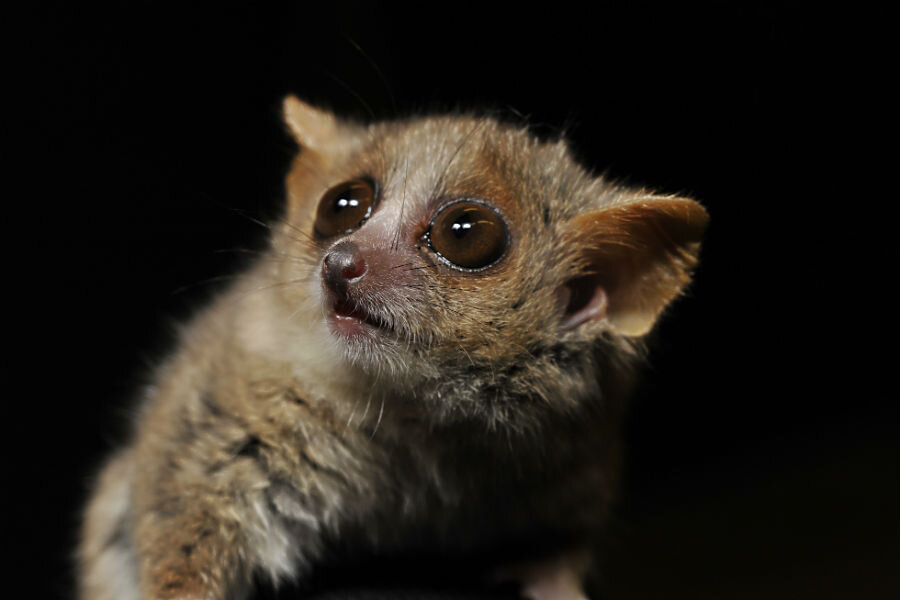Adorable lemur paints a picture of Madagascar's past
Loading...
"Shh! We're hiding. Be quiet everyone. That includes me. Shh! Who's making that noise? Oh, it's me again...."
So says Julien, King of the Lemurs, in "Madagascar," an animated movie that enhanced the aura surrounding its island namesake, a place blessed with a bewildering array of native species. In fact, since it split from mainland Africa about 160 million years ago, it has blazed such a pioneering evolutionary path that 95 percent of its reptiles, 92 percent of its mammals, and 89 percent of its plants exist nowhere else on Earth.
Perhaps the most iconic of all is the lemur – prosimian tree-dwelling primates with large amber eyes, long and sometimes striped tails, pointed muzzles, and soft fur. In a new research paper, published Monday in Proceedings of the National Academy of Sciences, scientists have studied the smallest of all, the mouse lemur, in an effort to better understand the history of this enchanting island. Their aim was to put to rest a longstanding debate over the history of Madagascar's forests, and how much blame its human inhabitants deserve for the levels of deforestation.
"The debate has become rather polarized," says lead author Anne Yoder, a biology professor at Duke University in Durham, N.C. There are those who insist the Central Highlands' grasslands are ancient, and thus bear minimal trace of human interference. Others counter they were lushly forested prior to human arrival, "and thus the original Malagasy people were solely responsible for destroying a forested paradise."
And how, exactly, can these "ridiculously cute" mouse lemurs, as Dr. Yoder describes them, help settle this debate?
The answer lies in the fact that these teacup-sized creatures – their head and body range from 2.25 inches to 4.75 inches – are the world's fastest-reproducing primates. As such, their collective DNA reflects changes in their surroundings faster than many other mammals, allowing biologists to build a picture of past environments.
The researchers analyzed the genomes from various mouse lemur species at 15 different sites across the island. They identified tens of thousands of changes in their DNA sequences. By subjecting these variations to statistical analysis, they gained insight into such questions as how long ago species and populations diverged, the likely geographical location of the oldest sequence types compared to the youngest, and the connections between genetic and geographic distance.
Answers to these questions can, in turn, provide information about where a species originated, how much its range has extended, and whether it still occupies its "ancestral" home or has found a new dwelling place altogether.
"The idea is that mouse lemurs will likely be the last 'holders on' in the face of deforestation, given that they, of all lemurs, are best able to survive in disturbed habitat," explains Yoder. "Thus, if we find forest patches that don't even contain mouse lemurs, we can infer that the forest has reached a point of no return."
The team's results suggest that the truth lies somewhere in the midst of the debate's extremes: While there can be no denying that human activities have profoundly altered the natural environment, the suggestion that the Central Highlands was a forested paradise before humans arrived seems unlikely. The evidence points, instead, to a mosaic of grasslands and forest.
Today, Madagascar is undeniably denuded of trees, a land dominated by vast open grasslands, with just a fringe of trees remaining on the outskirts, like the rim of a crown resting on a shaved head.
But, according to Yoder, there is "tremendous appetite" for reforestation in Madagascar. One example is the work of the Duke Lemur Center, which has run a community-based conservation initiative in the northeastern SAVA region since 2012. Yet the outlook depends upon more than conservation, says Yoder: The country's political stability is key, which in turn relies upon economic growth and sustainability.
"Madagascar is a heartbreakingly poor place," says Yoder. "The best way to help the lemurs is to help the Malagasy people live better lives."








